The ‘90s was a watershed era for gear, and set the template for the future of the electric guitar – these are the retro designs, digital innovations and misfit toys that defined a decade and beyond
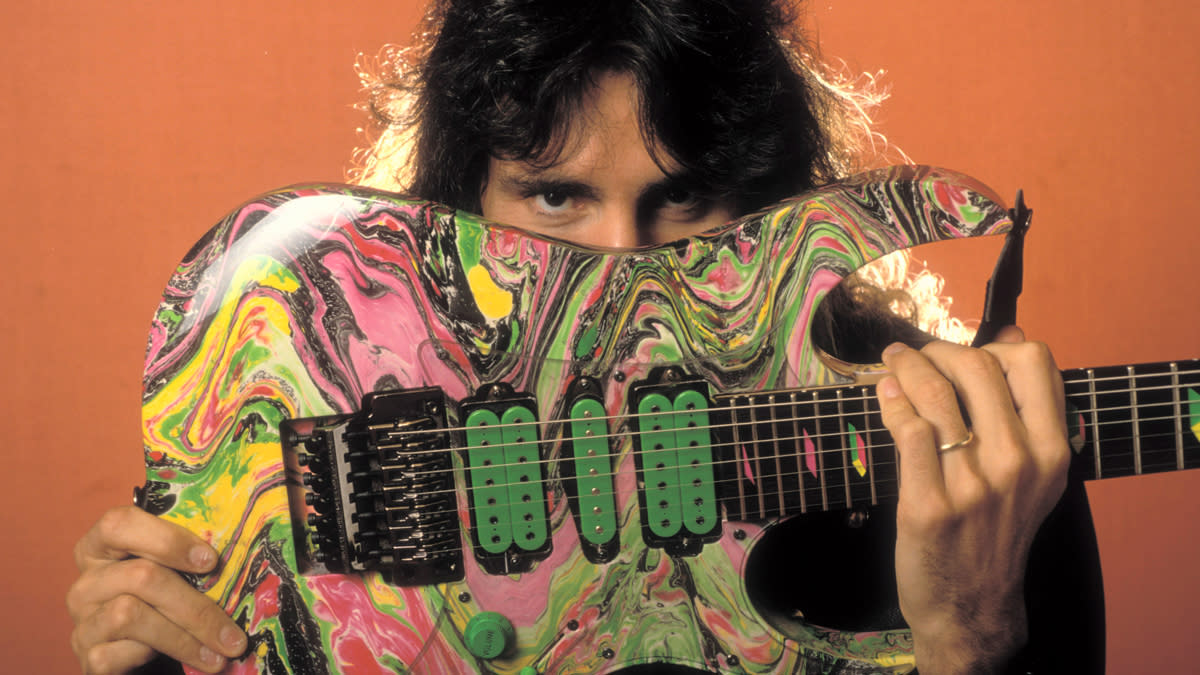
- Oops!Something went wrong.Please try again later.
Electric guitar technology progressed at a steady pace for four decades from the ‘50s through the ‘80s, but by the ‘90s many guitarists seemed ready for a break.
The sudden shift of the dominance of “hair metal” to grunge was partially responsible for the revolution against evolution that took place, as the renewed interest in guitars and effects from the past that developed seemed to be inspired more by a desire to challenge the status quo than nostalgia.
Another factor was the ever-increasing prices of Superstrats, rack effects and high-gain multi-channel amps, which helped cash-strapped musicians realize that many unpopular guitar models and low-tech classic stomp boxes maybe weren’t as crappy as they previously were led to believe.
Although retro spirit dominated the ‘90s, technology still progressed onward even as players were discovering the new-found joys of lipstick-tube pickups and germanium transistors.
The digital revolution was starting to gain steam, making crystal-clean multitrack recording affordable and accessible to home studios and providing credible duplications of desirable amps and effects through advanced modeling technology. And while high-gain multi-channel amps remained relatively expensive, amp designers continued to push the envelope to provide features and tones that guitarists still desired.
Retro/future arguments aside, perhaps the most exciting development for the musical instrument industry was how level the playing field had started to become. The boutique builder phenomenon gained a strong foothold that paralleled the success of independent record labels at the time, and soon even a small company with good products was able to thrive as players became more open and accepting of instruments and effects that were uncommon and unusual.
The following items represent some of the most significant trends and new products that emerged during the ‘90s.
Guitars
Retro guitars
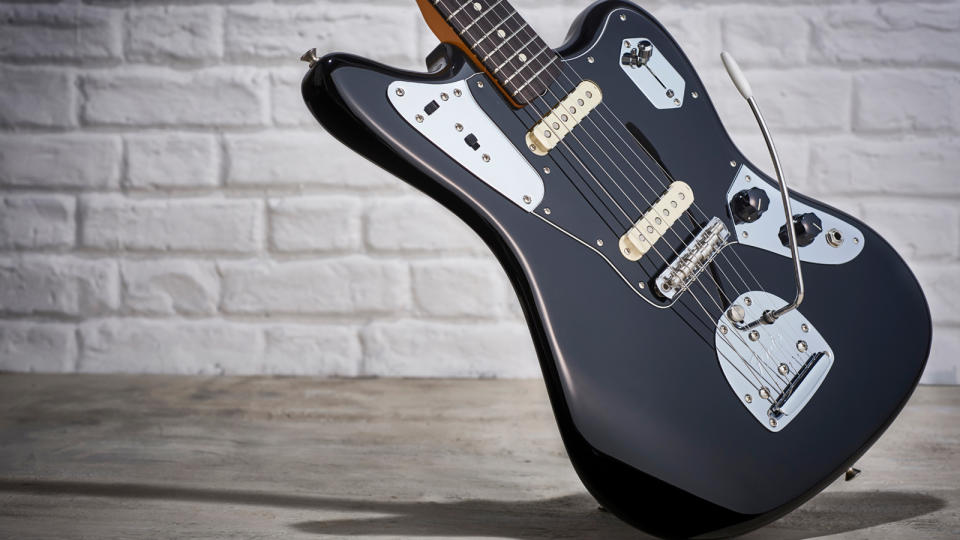
Although the pointy solidbody and super Strat designs that ruled the ‘80s didn’t entirely disappear, they faded into the background as traditional Les Paul, Strat and Tele designs returned to dominance during the ‘90s.
A more stunning and unexpected development was the rise of retro “misfit” guitars that earned a level of respect they never experienced before, particularly Fender Jazzmasters, Jaguars and Mustangs as well as previously ignored “pawn shop prize” solidbodies like the Guild S-100, which were reissued, thanks to their use by grunge icons.
The lo-tech innovations of Danelectro guitars from the ‘50s and ‘60s inspired everything from the lipstick tube pickups found on the Ibanez Talman and Charvel Surfcaster to the semi-hollow construction and phenolic laminate tops and backs of Reverend’s first models.
Even the Danelectro brand itself came back from the dead, joining several other newly resurrected brands from the past like Gretsch and Framus.
Ernie Ball Music Man EVH/Peavey Wolfgang
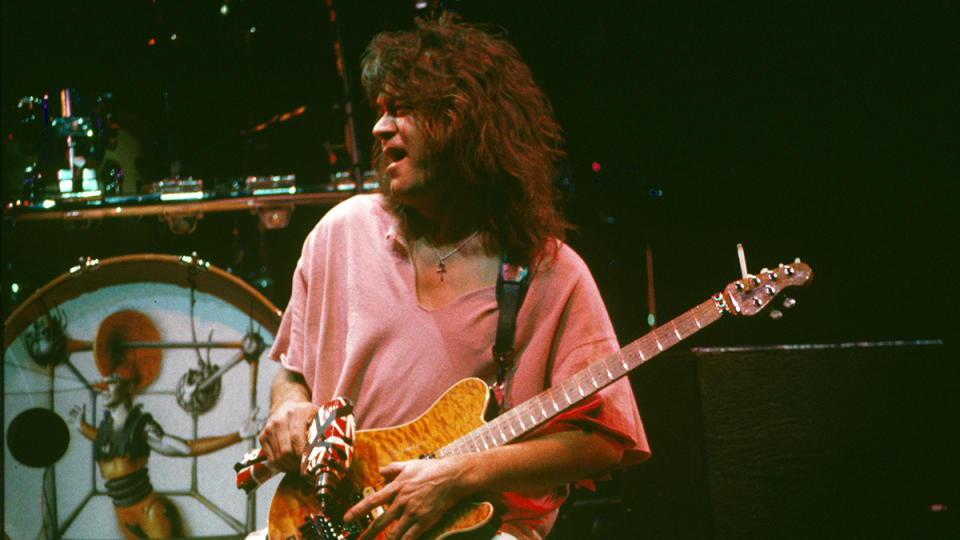
Although Eddie Van Halen endorsed Kramer guitars during the ‘80s, he never played any of their production models and Kramer never offered an official Van Halen signature model.
When Ed joined forces with Ernie Ball Music Man in the early ‘90s, he finally delivered the most highly anticipated signature model since the Les Paul. Ed was heavily involved in his Music Man signature model’s design, which included a neck that duplicated the shape of his favorite Kramer 5150 neck, a non-floating Floyd Rose and a single volume control with a “tone” knob.
Because of Music Man’s limited production capabilities (the company made only about 6,000 Van Halen guitars from 1991-1995), Ed switched to Peavey in 1995, which offered a modified version of the Music Man EVH signature design named the Wolfgang after Ed’s son.
PRS McCarty
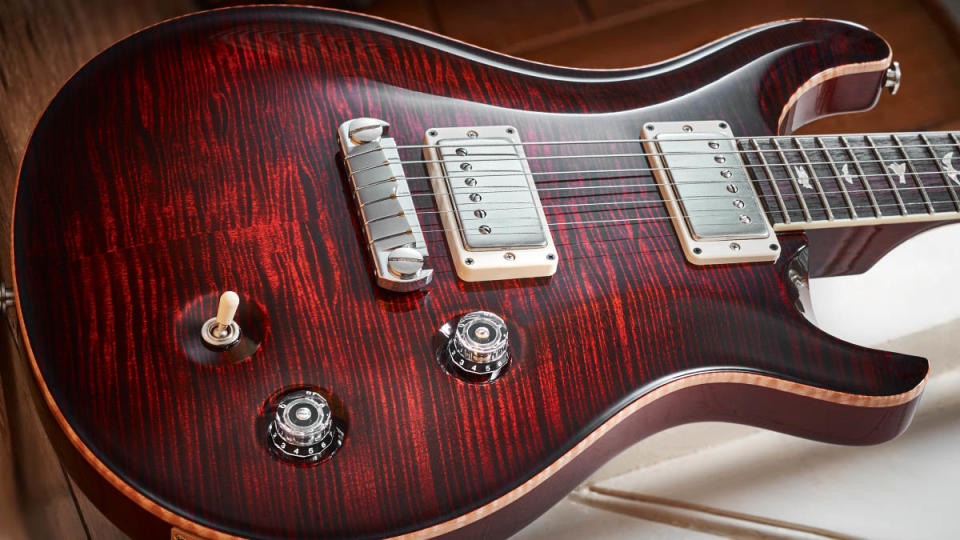
In the late ‘80s, Paul Reed Smith reached out to Ted McCarty, who was president of Gibson during its electric guitar “golden era” from 1950 to 1966, seeking McCarty’s wisdom about guitar building and production, which led to a long friendship between the two.
The PRS McCarty model introduced in 1994 represented the culmination of their collaborative know-how, combining the most desirable aspects of McCarty’s successful golden era designs with Smith’s sophisticated production techniques, attention to detail and relentless pursuit of perfection.
The PRS McCarty model represented the modern evolution of the vintage dual-humbucker maple-capped mahogany body set-neck design with its refined craftsmanship and enhanced playability. It has since become a classic in its own right.
Ibanez Universe UV7
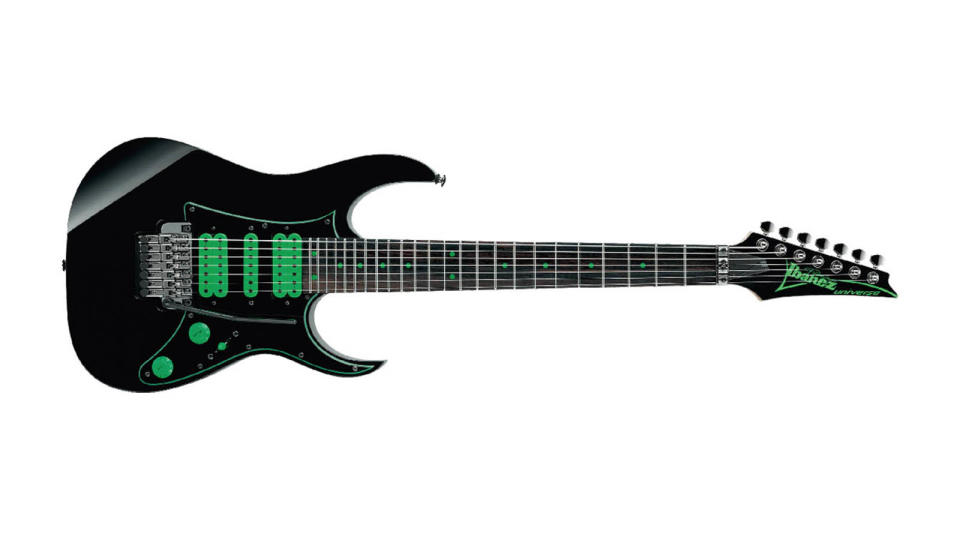
Introduced in 1990, the Ibanez Universe was the very first mass-produced seven-string solidbody electric, but despite playing a prominent role on Steve Vai’s best-selling Passion and Warfare album, it initially struggled due to its expensive price and later due to backlash against technical guitar playing.
However, as the ‘90s progressed, the Universe found new life in the hands of death metal guitarists like Trey Azagthoth of Morbid Angel and emerging nu-metal players like Munky and Head of Korn, who used it to pound out ultra-heavy rhythms.
Ibanez discontinued the Universe in 1994 around the time Korn released its debut album, but the model was resurrected in 1996 due to a massive surge in demand largely thanks to Korn’s incredible success and the instrument’s use by an increasing variety of bands like Deftones, Dream Theater, Fear Factory, Meshuggah and many others.
By the end of the decade, dozens of companies offered seven-string guitars and Ibanez offered numerous different models, including a seven-string acoustic.
Parker Fly
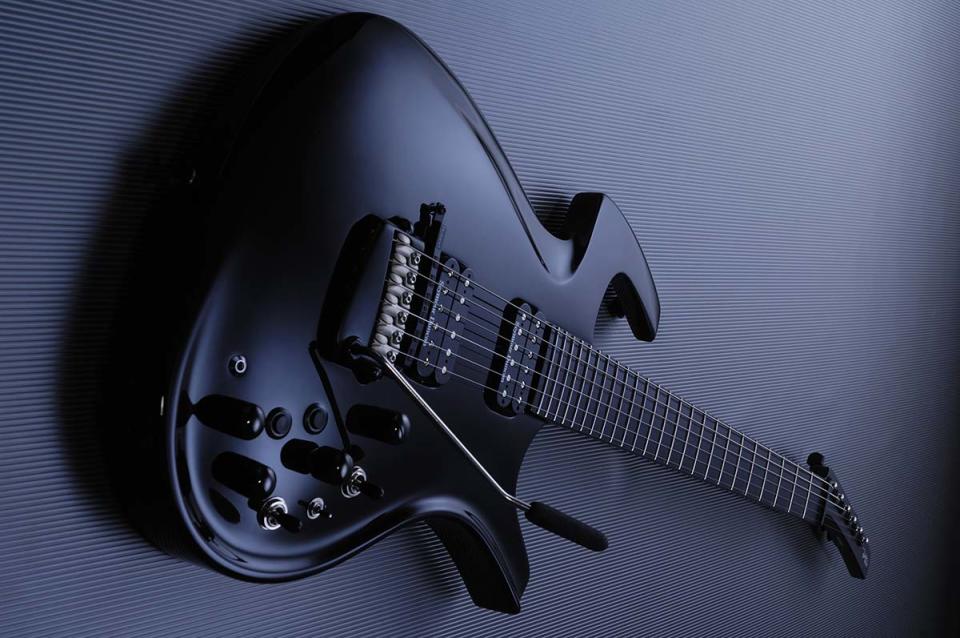
The Parker Fly was by far the most innovative mass-produced electric guitar introduced during the ‘90s. Although the body and neck were made of traditional tone woods, they were reinforced with a carbon fiber/fiberglass/epoxy resin composite exoskeleton that enabled an extremely slim, highly contoured body design with outstanding dynamics and sustain and acoustic-like resonance while reducing the weight to less than five pounds.
The fretboard was also made of composite material and featured 24 stainless steel tang-free frets glued to the fretboard. A combination of magnetic pickups (usually a pair of humbuckers although some models featured single coils) and optional Fishman piezo bridge delivered a wide range of electric and acoustic-electric tones. One of the Fly’s most ingenious innovations was its triple-mode vibrato system that could be set for floating, dive-only or fixed bridge operation.
Players like Adrian Belew, Amir Derakh, Reeves Gabrels and Dave Navarro embraced this radical design, but the Parker Fly never surpassed cult status and was discontinued in 2016.
Hamer DuoTone
Featuring a true hybrid electric-acoustic design that combined a spruce top and acoustic-style rosewood bridge with piezo pickups and a semi-hollow mahogany body with dual humbuckers, the Hamer DuoTone provided an ideal solution for guitarists who wanted to instantly switch between acoustic and electric sounds without switching instruments.
Released just before the Parker Fly, the DuoTone may have stolen some of the Fly’s thunder, particularly since its more traditional design conformed more to the era’s retro focus. Like the Fly, the DuoTone had an impressive list of pro users like Stone Gossard, Ty Tabor, Jeff Tweedy and Dweezil Zappa, but it also suffered a similar fate of not catching on with the greater guitar community.
Unplugged
Eric Clapton’s appearance on MTV Unplugged and his subsequent release of the Unplugged album, which soared to RIAA Diamond status (10 million units sold), had a profound effect on the acoustic guitar market during the ‘90s.
Clapton’s use of a pair of vintage Martins influenced a significant spike in sales of Martin guitars, which Martin capitalized on by issuing its first Eric Clapton signature model – the 000-28EC – in 1996.
Martin wasn’t the only acoustic guitar maker to benefit – sales of Taylor guitars also increased dramatically and even independent acoustic luthiers experienced a dramatic uptick in demand. Nirvana’s Unplugged appearance had a similar, albeit lesser, impact on the sales of lower-cost entry-level acoustic-electrics as grunge, alternative and post punk bands followed suit.
Amps
Boutique amps
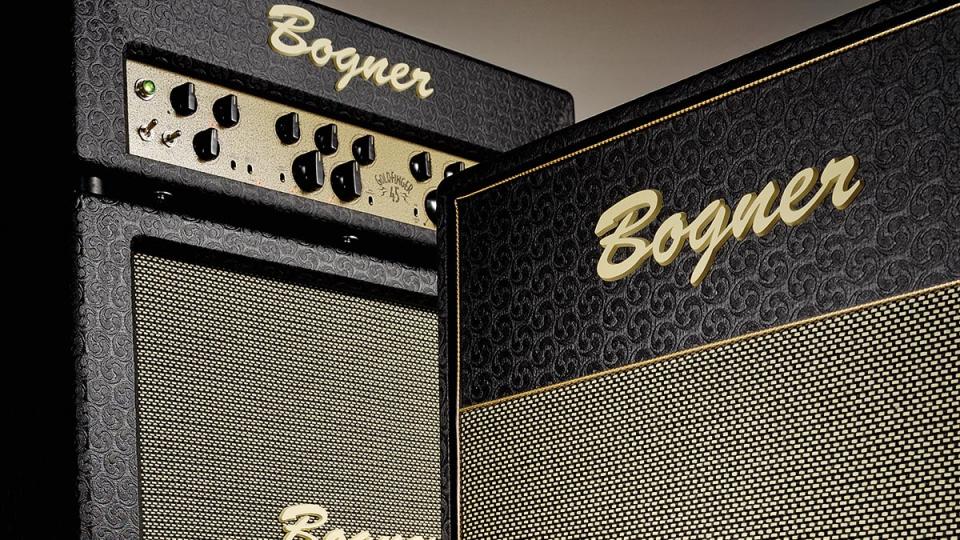
The boutique amp phenomenon did not start in the ‘90s, but whereas only a handful of builders like Dumble, Mesa/Boogie, Soldano, Trainwreck and others emerged during the ‘70s and ‘80s, the number of boutique amp builders and companies exploded exponentially during the ‘90s.
Bogner, Budda, Diezel, Dr. Z, Kendrick, Matchless, Naylor, Rivera, Tone King, Top Hat, Victoria, Voodoo, VHT and Wizard are just a handful of boutique amp companies that started or came to prominence during the decade.
Part of this movement was a natural progression of amp techs moving beyond doing modifications when the old Fenders and Marshalls they hot-rodded became too valuable on the vintage market to modify, while others were inspired to replicate classic Fender, Marshall and Vox amps that had become scarce.
Many boutique builders also developed innovative high-gain and multi-channel designs that significantly pushed amp technology forward. Even Fender (sort of) got into the boutique amp business, hiring designer Bruce Zinky and starting an amp custom shop that turned out the acclaimed Dual Professional, Tone Master and Vibro King models.
Mesa/Boogie Dual Rectifier
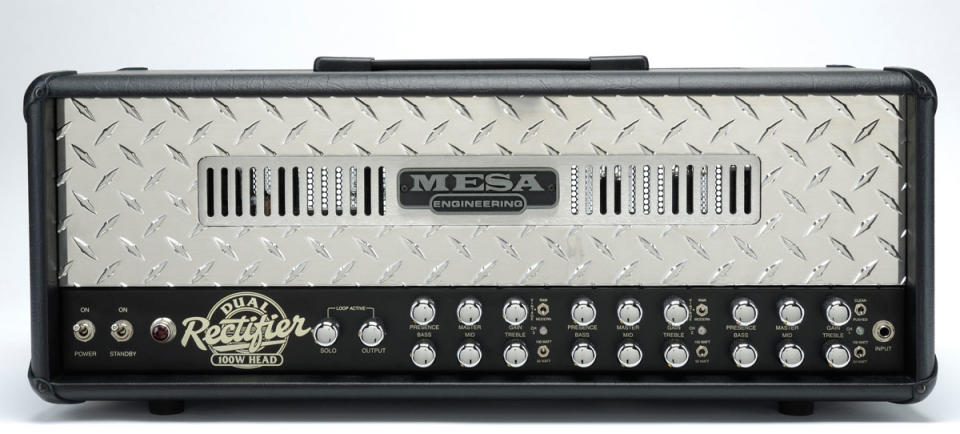
Randall Smith and his engineering team started designing the Dual Rectifier in the late ‘80s to satisfy the preferences of “hair metal” and hard rock players of that era and provide an alternative to the hot-rodded Marshalls and Soldano amps they preferred.
However, by the time the first Dual Rectifiers hit the market in late 1992, grunge had effectively killed hair metal. The ironic twist was that the Dual Rectifier was immediately embraced by several grunge bands, including Soundgarden and Alice in Chains.
During the mid- to late-‘90s, the ultra-heavy high-gain tones of the Dual Rectifier essentially defined the sound of heavy rock, alternative/punk and nu metal music of that era as it was used by numerous popular bands, including Bush, Creed, Foo Fighters, Korn, Limp Bizkit, Metallica, Tool, 311 and dozens of others.
Peavey 5150
Around the same time that Eddie Van Halen was collaborating with Music Man on his first signature guitar, he also started working with Peavey on his first signature amplifier – the 5150. It took about two years for Ed and lead engineer James Brown to refine the production version of the 5150’s design before the first 5150 amps were shipped in 1992.
A 120-watt beast driven by four 6L6 power tubes and four cascading gain stages, the 5150 delivered an entirely new definition of the “Brown sound.” Its outrageously saturated distortion made it an instant favorite of British metal producers Colin Richardson and Andy Sneap, who made the 5150 as popular in extreme and underground metal circles as the Dual Rectifier was in mainstream genres.
Matchless DC30
Rick Perrotta and Mark Sampson started the Matchless company in 1989 and offered a variety of impressive amp models during the ‘90s.
Developed as a more reliable alternative to a Vox AC30, the Matchless DC30 2x12 combo was actually more like a hybrid of an AC30 Top Boost (channel 1) and AC15 (channel 2), thanks to channel 2’s high-gain EF86 pentode preamp tube. Channel 2 also featured a six-position tone switch that engaged different coupling capacitors that provided a variety of different tones.
The DC30 and its head-only counterpart the HC30 were quickly embraced by a wide variety of high-profile pros, including Jimmie Vaughan, Stone Gossard and Mike McCready (Pearl Jam), Dave Matthews, John Rzeznik (Goo Goo Dolls), Dave Pirner (Soul Asylum), studio legend Mike Landau and country producers and session players like Kenny Greenberg, John Jorgenson and Brent Mason.
Digital amp modeling
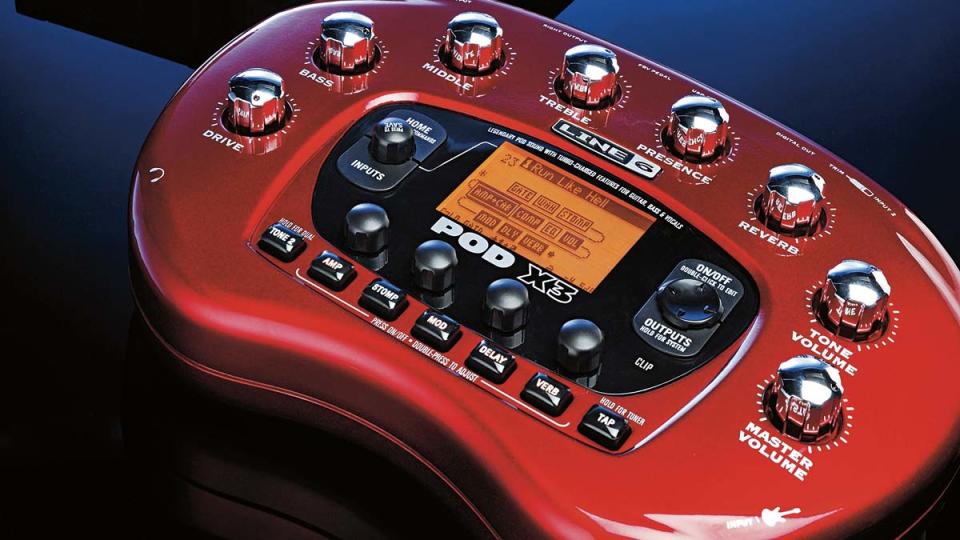
In 1996 Line 6 introduced the world to the wonders of digital amp modeling with the AxSys 212 combo. It was followed shortly afterwards by various Johnson Amplification (a division of DigiTech) models, including the flagship One Fifty and Two Fifty combos.
Interestingly, the earliest digital amp modelers packaged as combo amps experienced disappointing sales figures, but when Line 6 offered the same technology in 1997 as the Amp Farm real-time TDM software plug-in for Pro Tools and in 1998 as a compact standalone processor called the POD, which sold thousands of units, guitarists eventually warmed up to digital modeling, paving the way for the various amps, processors and software available today.
Even though digital modeling employed state-of-the-art technology, it fit in perfectly with the retro ‘90s by providing the authentic sounds of classic amps and effects for the stage and studio without the expense, bulk and upkeep of collecting the real deal.
Sovtek
The dissolution of the Soviet Union in the early ‘90s was bad for weapons sales, but it was good for the electric guitar industry.
Mike Matthews, the founder of Electro-Harmonix, was already involved in the manufacture and export of vacuum tubes via New Sensor’s Sovtek brand, and during the early ‘90s Sovtek expanded its efforts into making effect pedals like the Big Muff fuzz and Small Stone phase shifter and affordable guitar amp heads, reportedly built in former military factories.
The Sovtek MIG series amps were designed by Tony Bruno and consisted of a variety of models: the MIG-30, MIG-50, 50-watt Tube Midget, MIG-60, MIG-100 and high-gain MIG-100H.
Featuring a sound described as a combination between a Fender Bassman and Marshall Plexi, Sovtek MIG amps had their own distinct vibe. Priced well under $1,000, these amps provided a hell of a lot of rock for your ruble.
Pedals/Effects
Fuzz
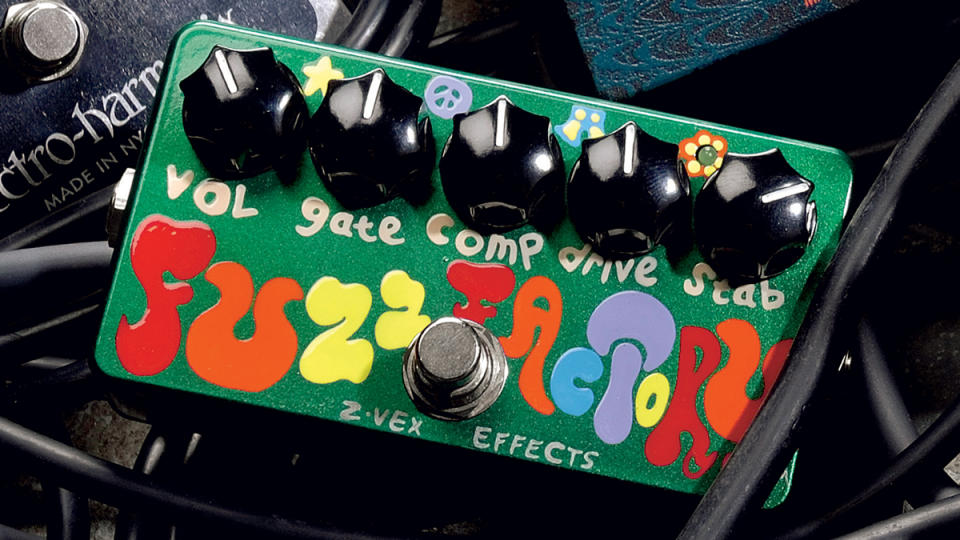
Although guitarists never stopped using fuzz pedals since the first units appeared in the ‘60s, during the ‘80s fuzz was mostly used as a sort of “appetizer” during solos by players like Adrian Belew, David Gilmour, Eric Johnson and Stevie Ray Vaughan.
However, during the ‘90s fuzz became the full-meal deal, as players like Mudhoney’s Mark Arm and Steve Taylor, Kurt Cobain, Billy Corgan, J. Mascis, Buzz Osborne and many others used fuzz as a main component of their guitar tones.
Fuzz wasn’t just for grunge either, as a wide variety of bands like White Zombie, Korn, Ministry, Nine Inch Nails, Radiohead, Red Hot Chili Peppers, Fu Manchu and Sonic Youth also wallowed in fuzz’s filthy sounds.
As prices for vintage fuzz stomp boxes soared, boutique pedal builders filled the void with designs based on the Big Muff, Fuzz Face, Super Fuzz and Tone Bender as well as outrageous new circuits like the Z.Vex Fuzz Factory.
Boutique pedals
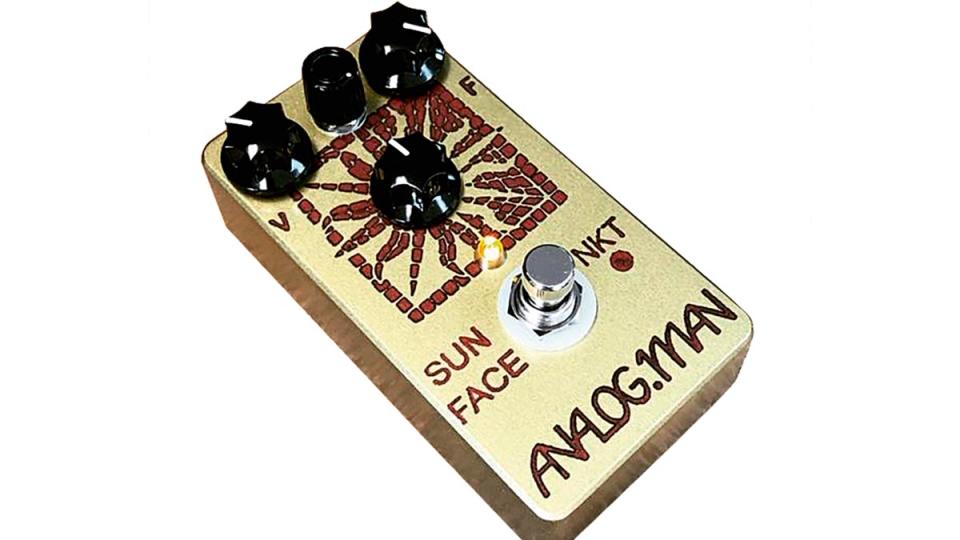
Renewed interest in the simple joys of stompbox effects led to a sudden surge of small, independent pedal companies during the ‘90s, many of which were staffed by only a handful of employees and operated out of basements or garages.
Demand for pedals made from elusive, obsolete components increased as taste for vintage tones grew, and whereas large manufacturers couldn’t convince their accountants that building units in limited runs of a dozen, a few hundred or even thousands would be profitable, boutique builders were able to do so and thrive.
Independent pedal companies that emerged during the ‘90s included Analog Man, Black Cat, Frantone, Fulltone, Klon, Prescription, Way Huge and Z. Vex in America, Lovetone in England, and Bixonic and Sobbat in Japan.
Klon Centaur
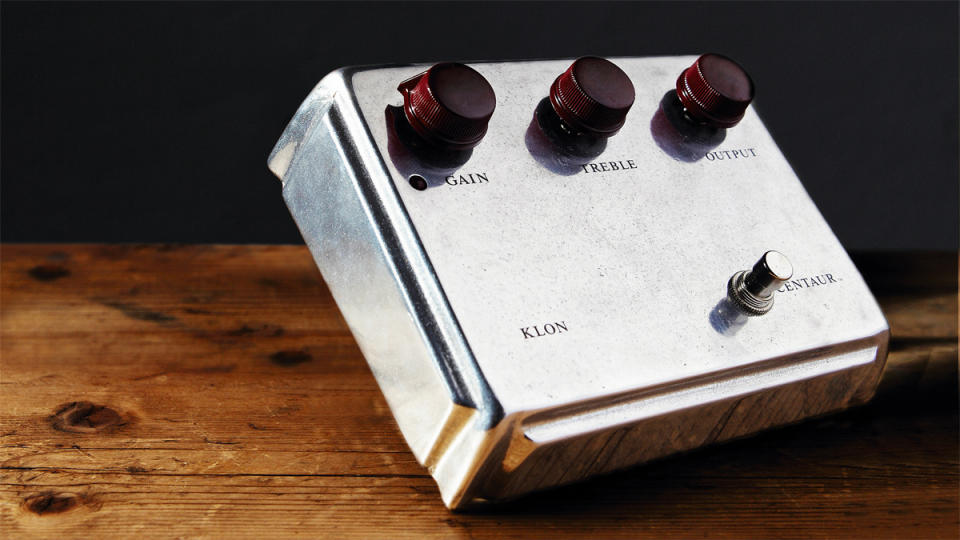
Guitarists rarely talked about things like “clean boost” or “transparent overdrive” before Bill Finnegan unleashed the legendary Klon Centaur upon the world in 1994, but after most guitarists plugged into a Centaur those elusive tonal qualities became essential.
The Klon Centaur was really more of a sonic sweetener, providing a slight boost of “just right” midrange frequencies and overdrive that fattened up tone in the good way, similar to what a tube amp pushed to its sweet spot should do, without changing the rig’s tonal character significantly.
Demand for the Centaur far exceeded Finnegan’s production capabilities, which eventually drove prices into the stratosphere and inspired the huge variety of Klon clones seen today.
Boss MT-2 Metal Zone
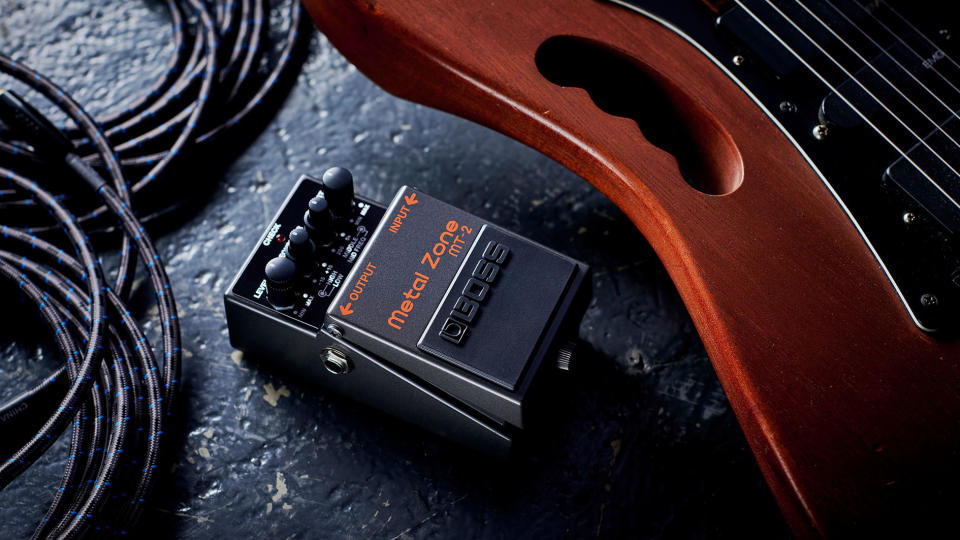
Released in 1991, the Boss MT-2 Metal Zone was an instant hit that has remained in continuous production ever since and sold more than a million units.
Something that popular is bound to have its detractors, but the criticism usually comes from individuals who are too lazy to dive into the intricacies of the Metal Zone’s rather powerful and somewhat sensitive “tweaky” EQ section, which can dial in an incredible range of tones both sublime and sloppy.
Thanks to ’90s users like At the Gates, Cannibal Corpse, Korn, Marty Friedman (whose rig during Megadeth’s Countdown to Extinction era was photographed containing two Metal Zones) and many others, the MT-2 has rightfully earned stature as a bona fide metal icon.
DigiTech Whammy WH-1
Introduced in 1989, the first-generation DigiTech Whammy WH-1 took a while to catch on with guitarists, but when it finally did by the early and mid ’90s it seemed like almost everyone used one.
It became an instrument unto itself in the hands of Tom Morello with Rage Against the Machine, but other prominent users who established the WH-1’s iconic status during the ’90s included Dimebag Darrell, Jonny Greenwood, both James Hetfield and Kirk Hammett with Metallica, David Gilmour, Steve Vai, Joe Satriani, Kevin Shields and more.
Later versions like the Whammy II and XP-100 Whammy-Wah found favor with players like Trey Anastasio and Korn, but the glitchy quirks and gritty lo-fi tone of the WH-1 made it indispensable for initial Whammy fans like the Edge, who snatched up every available WH-1 he could find.
Tech 21 SansAmp
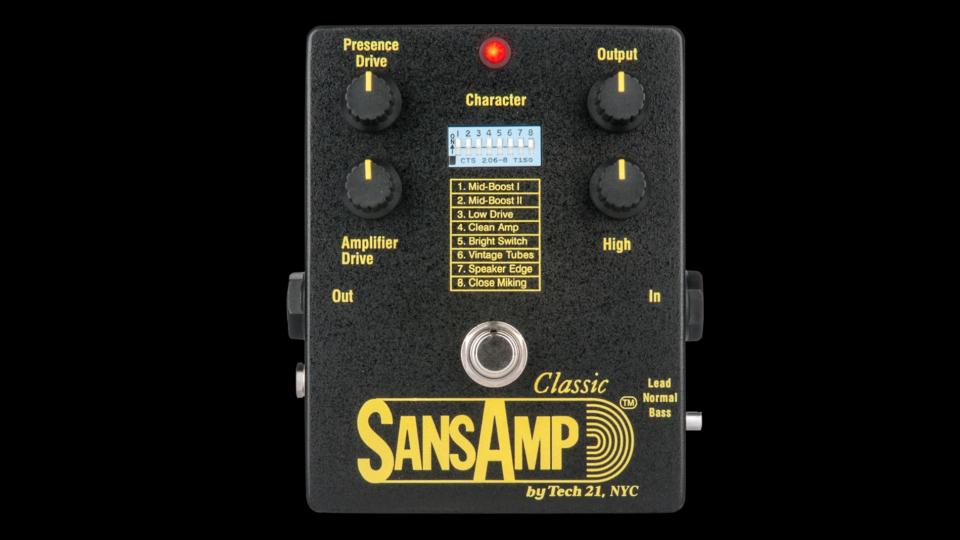
The original Tech 21 SansAmp is another product that actually came out in 1989 but made significant impact throughout the ’90s. It is probably best known for its use by Kurt Cobain in his rig as an overdrive pedal, but this revolutionary all-analog amp emulator was also a not-so-secret weapon of dozens of recording engineers and producers, including Tchad Blake who used it on everything and not just guitars.
Its ability to replicate the tonal personality of Fender, Marshall and Mesa Boogie amps made it a godsend for direct recording applications, and as a result it was employed to great effect on numerous recordings. After Tech 21 introduced additional SansAmp products, the original SansAmp was renamed the SansAmp Classic.
Recording
Digidesign Pro Tools
Digital recording technology became affordable to the masses during the ‘90s, thanks to the introduction of standalone hard disk recorders like the Fostex DMT-8, Roland VS-880, Yamaha 02R and Zoom HD8, and digital multitrack tape recorders like the Alesis ADAT.
But the real game-changer was Digidesign’s Pro Tools, which employed software, PCI cards and AD/DA hardware to turn a computer into a digital multitrack workstation.
The power and capabilities of Pro Tools increased rapidly throughout the ‘90s, and by 1999 when Digidesign introduced Pro Tool 24 MixPlus producers were able to complete projects from tracking through mastering entirely “in the box” using only Pro Tools.
Digidesign also introduced the home studio-oriented Digi 001 at the end of 1999, making Pro Tools the new standard for digital recording for pros and project studios alike.

